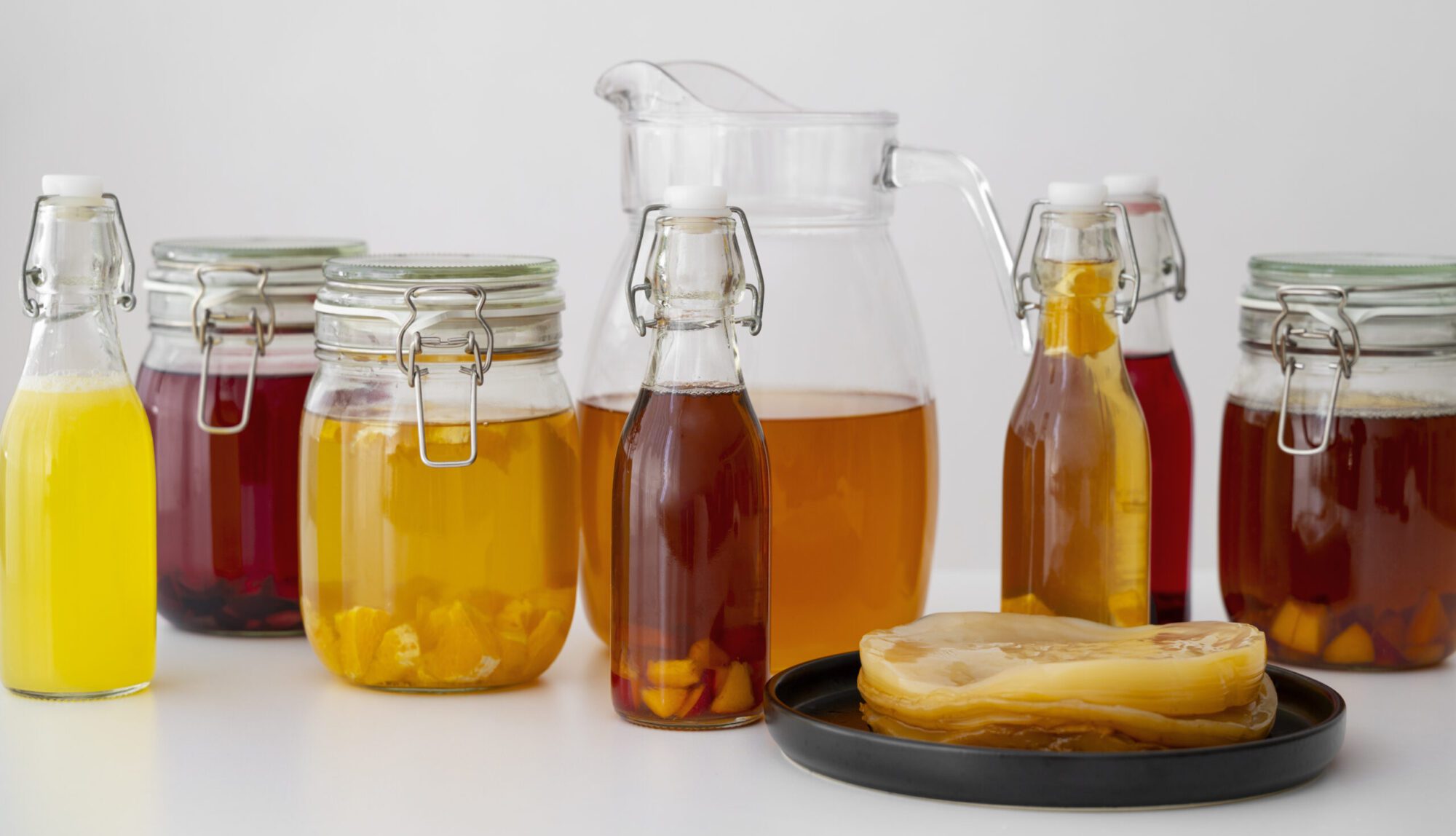The Ultimate Guide to Brewing Your Own Kombucha at Home

The Ultimate Guide to Brewing Your Own Kombucha at Home
The Ultimate Guide to Brewing Your Own Kombucha at Home
Kombucha is a fermented tea that has gained popularity over the years for its potential health benefits and unique flavor. It’s a beverage that has been enjoyed for centuries, with roots in China, and is known for its probiotic properties that can aid in digestion and overall gut health. While it’s readily available for purchase in many grocery stores and health food stores, there’s something really satisfying about brewing your own at home. Not only is it more cost-effective, but it also allows you to experiment with different flavors and tailor the brewing process to your own preferences.
In this ultimate guide, we will walk you through the step-by-step process of brewing your own kombucha at home, including the equipment you’ll need, the ingredients and their importance, the brewing process, tips for flavoring, and how to store and enjoy your homemade kombucha.
Equipment
Before you start brewing your own kombucha at home, it’s important to gather the necessary equipment to ensure a smooth and successful fermentation process. Here’s what you’ll need:
1. A large glass jar: You’ll need a large glass jar to ferment your kombucha in. Look for a 1-gallon glass jar with a wide opening, as this will make it easier to add and remove ingredients.
2. A breathable cloth: To cover the glass jar during the fermentation process, you’ll need a breathable cloth such as a cheesecloth or coffee filter. This will allow air to flow through while keeping out contaminants.
3. Rubber band: To secure the breathable cloth over the glass jar, you’ll need a rubber band or string.
4. A wooden or plastic stirring utensil: Avoid using metal utensils when working with kombucha, as they can react with the acidic liquid.
5. A pH strip or pH meter: It’s helpful to have a pH strip or meter to test the acidity of your kombucha during the fermentation process.
6. Bottles for bottling: Once your kombucha is ready to bottle, you’ll need smaller glass bottles to store it in. Look for 16-ounce glass bottles with airtight seals.
7. Funnel: A small funnel can also be helpful for bottling your kombucha without making a mess.
8. A pot: For boiling water and brewing the tea.
Ingredients
The main ingredients for brewing kombucha are tea, sugar, and a SCOBY (symbiotic culture of bacteria and yeast). Here’s a breakdown of each ingredient and its importance:
1. Tea: The type of tea you choose will influence the flavor of your kombucha. Black tea is the most commonly used for its robust flavor, but you can also use green tea, white tea, or a combination of different teas to create a unique flavor profile.
2. Sugar: The sugar serves as food for the SCOBY during the fermentation process. While it may seem counterintuitive to add sugar to a healthy beverage, most of the sugar is consumed by the SCOBY, leaving you with a tangy and slightly sweet finished product.
3. SCOBY: The SCOBY is the living culture that transforms the sweet tea into kombucha through fermentation. It is a rubbery disc that may look strange at first, but it’s the heart of the kombucha brewing process. If you don’t already have a SCOBY, you can obtain one from a friend who brews kombucha or purchase one online.
4. Starter liquid: In addition to the SCOBY, you’ll need some starter liquid to kickstart the fermentation process. This can be some of the liquid from a previous batch of kombucha or store-bought plain kombucha, which will contain the necessary bacteria and yeast to get the fermentation process going.
Brewing Process
Now that you have your equipment and ingredients, it’s time to start the brewing process. Here’s a step-by-step guide to brewing your own kombucha at home:
1. Boil water: Bring a pot of water to a boil, then remove it from the heat and add your tea bags or loose-leaf tea. For a 1-gallon batch of kombucha, you’ll want around 6-8 tea bags or 2-3 tablespoons of loose-leaf tea.
2. Steep the tea: Let the tea steep for 15-20 minutes, then remove the tea bags or strain the loose-leaf tea. Add your sugar (around 1 cup per gallon of brewed tea) and stir until dissolved. Let the sweetened tea cool to room temperature before proceeding.
3. Add starter liquid: Once the sweetened tea has cooled, transfer it to your fermentation jar. Add the SCOBY and the starter liquid, then cover the jar with the breathable cloth and secure it with a rubber band.
4. Fermentation: Place the jar in a warm, dark place and let it ferment for 7-10 days. Check the pH of the kombucha using a pH strip or meter to track its progress. You’ll notice the liquid becoming more acidic as it ferments.
5. Taste test: After 7 days, start tasting the kombucha to see if it’s reached the desired level of tartness. If not, let it ferment for a few more days until it reaches your preferred level of acidity.
6. Bottle the kombucha: Once the kombucha has reached the desired level of tartness, it’s time to bottle it. Remove the SCOBY from the jar and set it aside in a small amount of the liquid to use as a starter for your next batch. Using a funnel, pour the kombucha into clean glass bottles, leaving a little bit of space at the top.
Flavoring
Now that you have bottled your kombucha, you can experiment with flavoring it. You can leave it plain for a classic and tangy flavor, or you can add fruit juice, herbs, or spices to create unique flavor combinations. Here are some flavoring ideas to get you started:
1. Fruit juice: Add a splash of your favorite fruit juice to the bottled kombucha for a fruity twist. You can also add whole pieces of fruit for a more intense flavor.
2. Herbs and spices: Infuse your kombucha with fresh herbs or spices like ginger, mint, lavender, or cinnamon sticks. Simply add them to the bottles of kombucha and let them steep for a few days before enjoying.
3. Second fermentation: If you want to take your flavoring to the next level, you can do a second fermentation with your flavored kombucha. Simply seal the bottles of flavored kombucha and let them ferment at room temperature for a few days. This will create natural carbonation and intensify the flavors.
Storing and Enjoying
Once your flavored kombucha has undergone a second fermentation (if applicable), it’s time to store it in the refrigerator to slow down the fermentation process. This will preserve the flavor and carbonation and make it ready to enjoy whenever you desire. When serving your homemade kombucha, pour it into a glass and enjoy it over ice for a refreshing and probiotic-packed beverage.
In conclusion, brewing your own kombucha at home can be a fun and rewarding experience. With the right equipment, ingredients, and a little bit of patience, you can create a delicious and healthy beverage that you can enjoy anytime. Experiment with different flavors and find the perfect combination that suits your taste buds. Cheers to your newfound kombucha brewing skills and the joy of sipping on your own homemade creation!
[elementor-template id=”430″]
[elementor-template id=”433″]




0 Comments